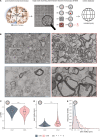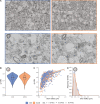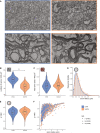Pathological ultrastructural alterations of myelinated axons in normal appearing white matter in progressive multiple sclerosis
- PMID: 37340488
- PMCID: PMC10283269
- DOI: 10.1186/s40478-023-01598-7
Pathological ultrastructural alterations of myelinated axons in normal appearing white matter in progressive multiple sclerosis
Abstract
Multiple sclerosis (MS) pathophysiology includes inflammation, demyelination and neurodegeneration, but the exact mechanisms of disease initiation and progression are unknown. A major feature of lesions is lack of myelin, which increases axonal energy demand and requires adaptation in number and size of mitochondria. Outside lesions, subtle and diffuse alterations are observed in normal appearing white matter (NAWM) and normal appearing grey matter (NAGM), including increased oxidative stress, reduced axon density and changes in myelin composition and morphology. On an ultrastructural level, only limited data is available on alterations in myelinated axons. We generated large scale 2D scanning transmission electron microscopy images ('nanotomy') of non-demyelinated brain tissue of control and progressive MS donors, accessible via an open-access online repository. We observed a reduced density of myelinated axons in NAWM, without a decrease in cross-sectional axon area. Small myelinated axons were less frequently and large myelinated axons were more frequently present in NAWM, while the g-ratio was similar. The correlation between axonal mitochondrial radius and g-ratio was lost in NAWM, but not in NAGM. Myelinated axons in control GM and NAGM had a similar g-ratio and radius distribution. We hypothesize that axonal loss in NAWM is likely compensated by swelling of the remaining myelinated axons and subsequent adjustment of myelin thickness to maintain their g-ratio. Failure of axonal mitochondria to adjust their size and fine-tuning of myelin thickness may render NAWM axons and their myelin more susceptible to injury.
Keywords: Electron microscopy; Human brain (bank); Mitochondria; Multiple sclerosis; Myelin; Nanotomy; Ultrastructure; g-ratio.
© 2023. The Author(s).
Conflict of interest statement
The authors declare that they have no competing interests.
Figures







Similar articles
-
Ultrastructural Axon-Myelin Unit Alterations in Multiple Sclerosis Correlate with Inflammation.Ann Neurol. 2023 Apr;93(4):856-870. doi: 10.1002/ana.26585. Epub 2023 Jan 5. Ann Neurol. 2023. PMID: 36565265
-
Axon-Myelin Unit Blistering as Early Event in MS Normal Appearing White Matter.Ann Neurol. 2021 Apr;89(4):711-725. doi: 10.1002/ana.26014. Epub 2021 Jan 27. Ann Neurol. 2021. PMID: 33410190 Free PMC article.
-
Deep learning-based segmentation in MRI-(immuno)histological examination of myelin and axonal damage in normal-appearing white matter and white matter hyperintensities.Brain Pathol. 2025 Mar;35(2):e13301. doi: 10.1111/bpa.13301. Epub 2024 Aug 23. Brain Pathol. 2025. PMID: 39175459 Free PMC article.
-
Review: Mitochondria and disease progression in multiple sclerosis.Neuropathol Appl Neurobiol. 2008 Dec;34(6):577-89. doi: 10.1111/j.1365-2990.2008.00987.x. Neuropathol Appl Neurobiol. 2008. PMID: 19076696 Free PMC article. Review.
-
Pathological abnormalities in the normal-appearing white matter in multiple sclerosis.Neurol Sci. 2001 Apr;22(2):141-4. doi: 10.1007/s100720170012. Neurol Sci. 2001. PMID: 11603615 Review.
Cited by
-
Ultrastructural membrane dynamics of mouse and human cortical synapses.bioRxiv [Preprint]. 2024 Dec 26:2024.12.26.630393. doi: 10.1101/2024.12.26.630393. bioRxiv. 2024. PMID: 39763840 Free PMC article. Preprint.
-
Unexpected Remyelination in the Absence of Matrix Metalloproteinase 7.Glia. 2025 Jun;73(6):1288-1306. doi: 10.1002/glia.70005. Epub 2025 Mar 10. Glia. 2025. PMID: 40059514 Free PMC article.
-
Trem2-deficiency aggravates and accelerates age-related myelin degeneration.Acta Neuropathol Commun. 2024 Sep 19;12(1):154. doi: 10.1186/s40478-024-01855-3. Acta Neuropathol Commun. 2024. PMID: 39300502 Free PMC article.
-
Multiple Sclerosis: Glial Cell Diversity in Time and Space.Glia. 2025 Mar;73(3):574-590. doi: 10.1002/glia.24655. Epub 2024 Dec 24. Glia. 2025. PMID: 39719685 Free PMC article. Review.
-
Pilot Study of the Total and Phosphorylated Tau Proteins in Early-Stage Multiple Sclerosis.Medicina (Kaunas). 2024 Feb 29;60(3):416. doi: 10.3390/medicina60030416. Medicina (Kaunas). 2024. PMID: 38541142 Free PMC article.
References
-
- Ramió-Torrentà L, Sastre-Garriga J, Ingle GT, et al. Abnormalities in normal appearing tissues in early primary progressive multiple sclerosis and their relation to disability: a tissue specific magnetisation transfer study. J Neurol Neurosurg Psychiatry. 2006;77:40. doi: 10.1136/JNNP.2004.052316. - DOI - PMC - PubMed
Publication types
MeSH terms
LinkOut - more resources
Full Text Sources
Medical

